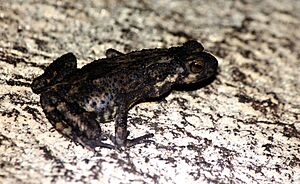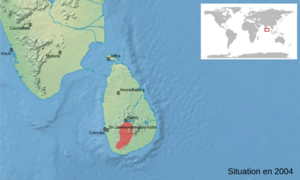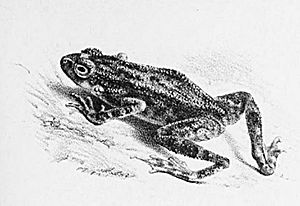Kelaart's toad facts for kids
Quick facts for kids Kelaart's toad |
|
|---|---|
 |
|
| Conservation status | |
| Scientific classification | |
 |
|
| Synonyms | |
|
Adenomus badioflavus Cope, 1860 |
Adenomus kelaartii (also known as Kelaart's toad or Kelaart's dwarf toad) is a special kind of toad that belongs to the Bufonidae family. This small toad lives only in Sri Lanka, an island country. You can find it in the southwestern parts of the island, living in places from 30 to 1,230 meters above sea level. The name kelaartii was given to honor Edward Frederick Kelaart, a doctor and animal expert from Sri Lanka.
Contents
What Kelaart's Toad Looks Like
Kelaart's toad is a pretty small toad. Female toads are usually about 36 to 50 millimeters (about 1.4 to 2 inches) long. Males are even smaller, measuring about 25 to 33 millimeters (about 1 to 1.3 inches).
Some of these toads have smooth skin. Others have skin with spiny bumps, like tiny warts. Their upper bodies are usually brown, sometimes with darker blotches. The underside of their bodies is cream or white. It often has brown blotches and can sometimes have red or even blue spots.
Where Kelaart's Toad Lives
Kelaart's toad lives only in the southwestern part of Sri Lanka. This means it is endemic to that area. You can find it in places up to 1,230 meters (about 4,000 feet) above sea level.
Its home range is not one big continuous area. Instead, it is broken up into several separate locations. These toads typically live in tropical humid forests. They like to stay in the leaf litter on the ground, especially near streams in the uplands.
Sometimes, you might see them climbing onto the lower parts of trees. They have also been spotted on sandbanks next to rivers. Other hiding spots include cracks in rocks, rotting logs, and holes in trees.
Life Cycle and Habits
Kelaart's toad is active both during the day and at night. During the breeding season, male toads make calls from next to water. They often sit on boulders in the middle of streams.
Female toads lay many eggs, sometimes up to one thousand. These eggs are colorless and are laid in a single long strand. They usually place their eggs in a permanent pool of water.
The baby toads, called tadpoles, are colorless at first. As they grow, they turn grey, and later become dark brown. After about seven weeks, the tadpoles go through metamorphosis. This means they change into tiny toads. These young toads are about 8 to 9 millimeters (about 0.3 inches) long when they leave the water.
Is Kelaart's Toad in Danger?
Kelaart's toad is quite common in the right habitats within its range. However, the total area where it lives is less than 500 square kilometers (about 193 square miles). Because of this, the International Union for Conservation of Nature (IUCN) has listed it as a "vulnerable species." This means it faces a high risk of becoming extinct in the wild.
The biggest danger to Kelaart's toad is the destruction of its forest home. Trees are cut down, and the land is then used for farming. Luckily, these toads live in several protected areas. The IUCN suggests that these protected places need to be managed even better to help save the toads.



